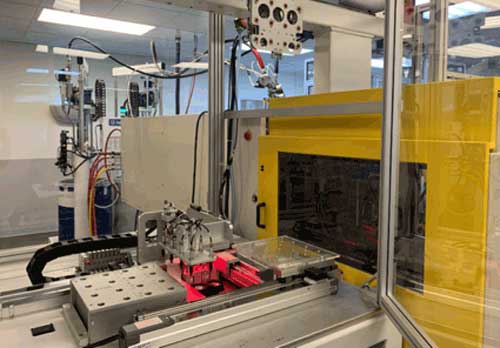White Papers
Putting the Science Back into LIM
December 6, 2021
Most of us recognize that the liquid injection molding (LIM) technology was invented and further developed back in the 1940’s and 1950’s ( 1946 screw injection extrusion machine, James Watson Hendry and 1956 reciprocating screw plasticator, W.H. Willert). Since those milestone inventions, many of the major manufacturers in the rubber industry have been continually developing clever refinements to the original process concept, upon which today’s technologies are founded. These refinements and improvements include a wide range of higher technologies; injection press efficiencies, mold tooling cavity construction, cold runner manifold technology, valve gate design and control algorithms, LIM material recipes, cold manifold runner systems, screw design and dosing systems – just to name a few.
Vernay Laboratories has focused on advances within LIM to create significant differentiation – as well as a solid leadership position in the precision rubber device market. Vernay’s technical capabilities include using the most current LIM processing and tooling approaches, but also combines processing expertise with a “trifecta” of scientific knowledge; mold processing, part geometry for specific applications and rubber recipe development, which one of Vernay’s significant core technologies. This unique combination of technologies is a “must have” in order to develop solutions for today’s most challenging market applications. These applications are trending towards using complex systems and incorporating more scientific / advanced technologies.
Vernay recognized years ago, that LIM processing and rubber material development for those processes requires several unique technical considerations due to the high processing shear, fast cycle times, complex tooling geometries, as well as meeting specific industry regulations for market applications. These regulatory aspects include, but are not limited to; medical biocompatibility (USP Class VI and ISO10993), potable water contact (WRAS, NSF61), low extractable pharmaceuticals and food grade materials (FDA 21CFR177.2600). Within these regulations are strict limitations on performance characteristics and laboratory tests that the materials must meet in areas such as; cytotoxicity, hemolysis, ingredient accelerator limitations, restricted ingredients, odor and taste, bacterial growth, etc. Translating these requirements into the science and chemistry requires consideration of viscosity, rheology and resulting physical properties such as modulus, resilience and chemical compatibility.
Knowing which chemical ingredients to select and mix into the rubber recipe so that the resulting rubber composite formulation can successfully withstand the LIM process environment, while also achieving faster vulcanization times AND ultimately exceeding these
stringent application requirements – is a significant differentiator that Vernay provides. There are many polymerizing manufacturers offering a wide range of LSR materials that are standardized and off-the-shelf. The variety of materials in the marketplace is growing each year, primarily in LSR (liquid silicone rubber). However, there are very few precision elastomeric device manufacturers, like Vernay, who can combine the technical application understanding, the LIM processing (scientific molding), tooling technical expertise and mastery of the rubber recipe chemistry – all in order to provide customers with the most effective solution. Imagine your most technical “one stop shop” for the market’s ever-challenging device specifications. That’s what Vernay Laboratories does. Every. Day.
Vernay R&D Materials Team has developed over 32,000 rubber recipes, 80 patents and has developed products in such a wide range of applications – it is nearly impossible to go through your day without using one of Vernay’s technologies. Vernay has extensive laboratory experience modifying the “off-the-shelf” LSR materials with additives and other ingredients mixed into the base polymers, so that Vernay can tailor recipes specifically for the marketplace and application.
Vernay’s Engineering and New Product Development Team have launched and implemented processing capabilities including; state of the art LIM, robotic automation, and vision systems. These technical developments have effectively reduced the amount of engineered rubber waste for each shot of the molding process, increased productivity and achieved higher per-press capacities, which ultimately requires lower overall investment per project.
Yes, Vernay can do all that. So……………..if it’s critical or complex, go with Vernay!

Vernay Laboratories has been a technology leader in the design, development, and manufacture of customized flow-control components since its founding in 1946. The company also formulates its own compounds to address each specific application.
Vernay’s products play a vital role in millions of medical devices, automobiles, and consumer products. Today, the privately held firm produces more than 1 billion components per year, drawing from a library of more than 33,000 elastomeric materials and compound formulations. It operates six plants around the world, in the U.S., the Netherlands, Italy and China. For more information, visit www.vernay.com.